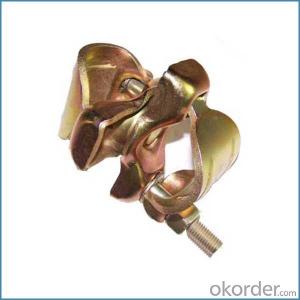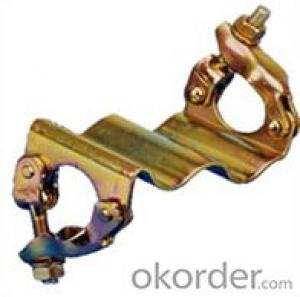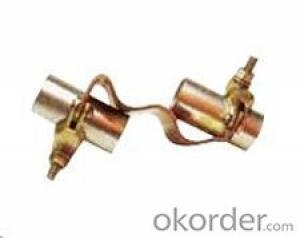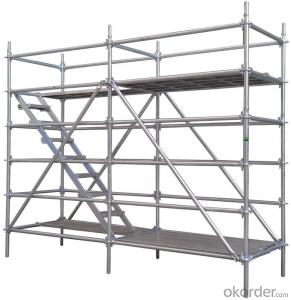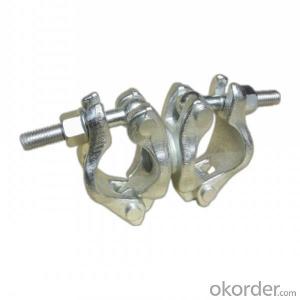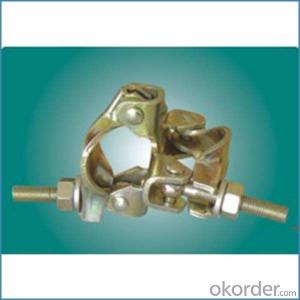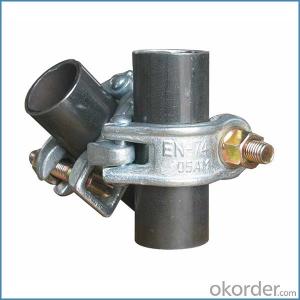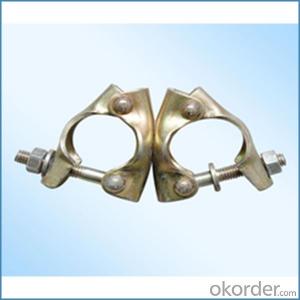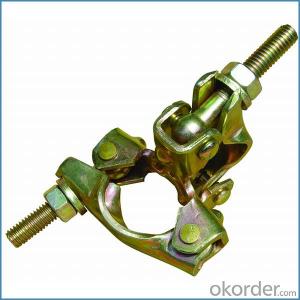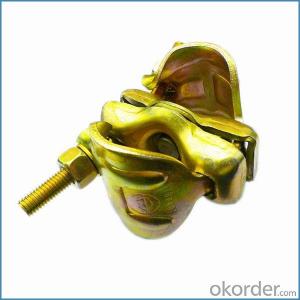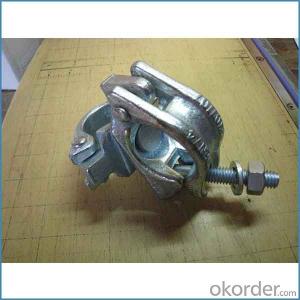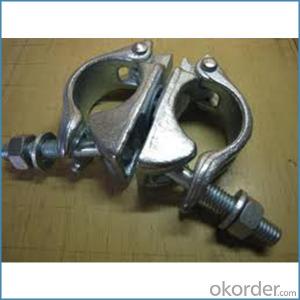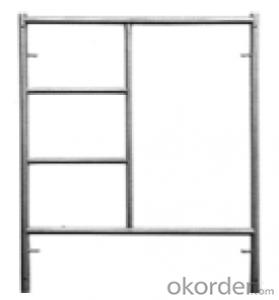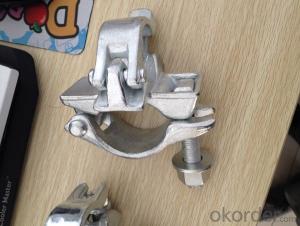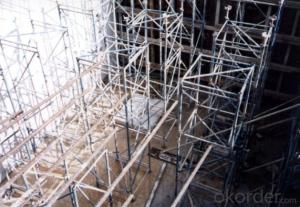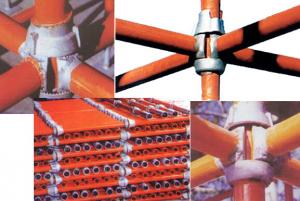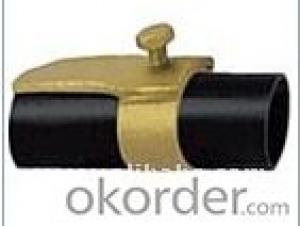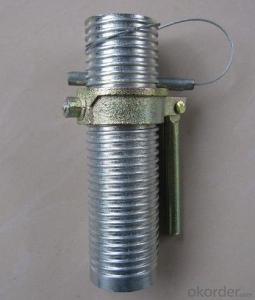Right Angle Coupler British Type for Sale
- Loading Port:
- Tianjin
- Payment Terms:
- TT OR LC
- Min Order Qty:
- 1000 kg
- Supply Capability:
- 100000 kg/month
OKorder Service Pledge
OKorder Financial Service
You Might Also Like
Right Angle Coupler British Type for Sale
Description
1.The scaffolding coupler is always used to connect the steel pipe as scaffolding system.
2.The often used coupler is swivel coupler and righ angle coupler .
3.We can provide types of scaffolding coupler according to your requirement.
4.Couoler can fix the 48.3mm scaffolding steel pipe tightly and make the whole scaffolding system more steadily.
5.Material:Q235 steel
6.Overall Size:48.3mm*48.3mm
7.Surface Finish: Galvanized/ Painted
8.Standard:BS1139,EN74
9.Package:25pcs/bag
10.Manufactuering as per customer requirements
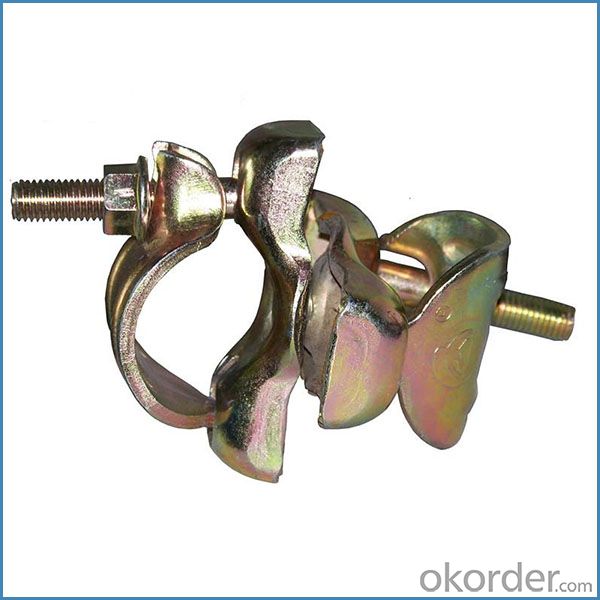
Feature
(1)Excellent Anti-Breaking—Cold Pressed Steel
(2)Outstanding Resistance Deformation
(3)Strong Anti-Dropping Ability
(4)Longtime USe
(5)Qualtity Guaranteed
(6)OEM Service
Photo
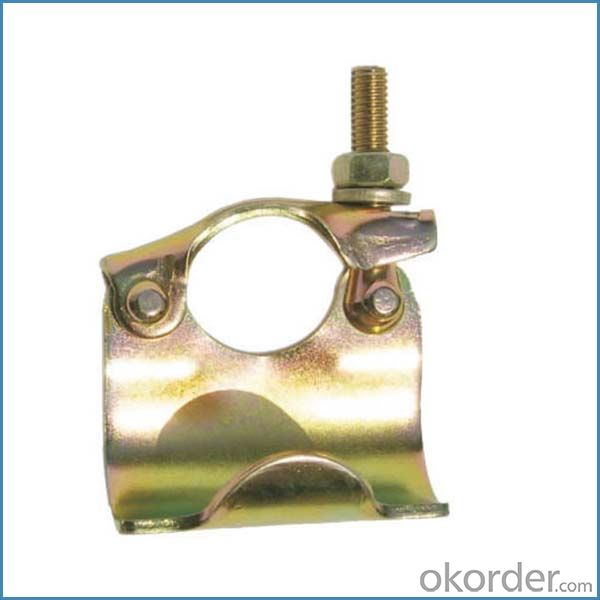
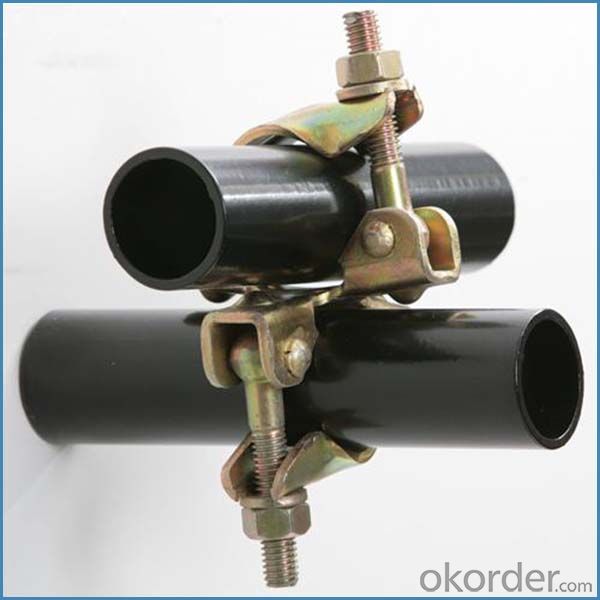
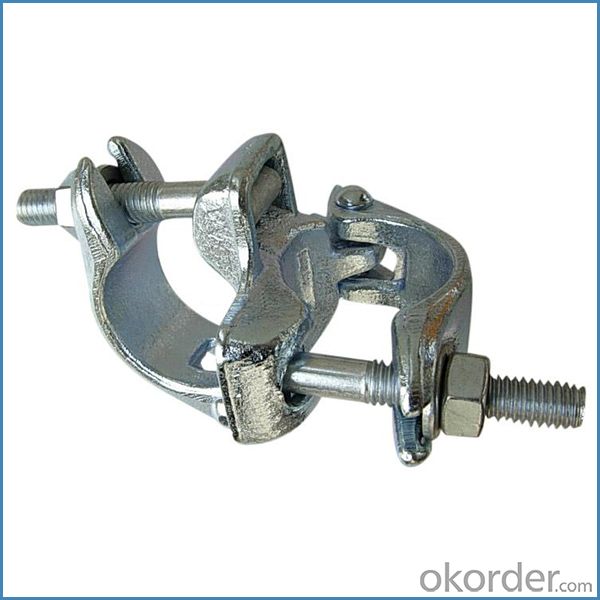
Parameter
| Material | Q235,345steel |
| Size | 48.3mm*48.3mm |
| Surface finish | Galvanized |
| Weight | 1.1kg around |
| Standard | BS1139,EN74 |
| Package | 25pcs/bag,steel pallet |
| Manufacture | As per customer requirement |
| Market | Africa, South America, the Middle East and Asia |
FAQ
Q: Are you a factory or trading company?
We are a state-owned corporation in China,dealing with various kinds of building materials.We have our holding subsidiaries.
Q: Where is your factory located? How can I visit there?
Our factory is located all around China.
Q: Can I get some samples?
Sample is free, customer only pay freight for the first time.
Q: Delivery?
10-30days. (5-15 containers)
Any question,feel free to contact us.
- Q: What are the common installation methods for steel tube couplers in scaffolding?
- Depending on the particular requirements and design of the scaffolding system, there are various installation techniques commonly employed for steel tube couplers. One frequently utilized approach is the sleeve or compression method. Here, the steel tube coupler is positioned over the two tubes requiring connection and subsequently secured by tightening bolts or nuts. This results in a stable and firm bond between the tubes, promoting safety and stability within the scaffolding structure. Another technique is the swivel method, utilized when a flexible joint is needed in the scaffolding system. The steel tube coupler employed in this method is equipped with a swivel mechanism, allowing the connected tubes to rotate or pivot. This proves advantageous in situations where the scaffolding must adapt to uneven surfaces or changes in angles. Additionally, the wedge method is often employed to expedite the installation of steel tube couplers. In this method, the coupler is positioned between the tubes, and a wedge is inserted to secure the connection. This approach is efficient and time-saving, making it particularly suitable for large-scale scaffolding projects. It is important to note that regardless of the chosen installation method, proper alignment and tightening of the steel tube couplers according to recommended torque specifications are essential. This ensures the structural integrity of the scaffolding system and the safety of workers utilizing the scaffolding.
- Q: How do you calculate the required quantity of steel tube couplers for a scaffolding project?
- To calculate the required quantity of steel tube couplers for a scaffolding project, you would need to determine the number of connections between tubes. This can be done by counting the number of joints in the scaffolding design or by referring to the project's blueprint. Once you have the total number of connections, you can estimate the quantity of steel tube couplers needed by assuming one coupler for each connection. It's always recommended to add a few extra couplers for any unforeseen requirements or replacements.
- Q: Can steel tube couplers be used for scaffolding projects on uneven or unstable ground?
- Steel tube couplers can be used for scaffolding projects on uneven or unstable ground, but additional measures need to be taken to ensure stability and safety. Uneven or unstable ground can pose a challenge for scaffolding as it may affect the overall stability and integrity of the structure. To address this issue, several steps can be taken. Firstly, a thorough assessment of the ground conditions should be conducted to determine the extent of the unevenness or instability. This assessment can be done by a qualified engineer or an experienced scaffolding professional. Based on the assessment, appropriate measures can be implemented. These may include using adjustable base plates or adjustable jacks to accommodate for uneven ground. These devices allow the scaffolding to be leveled and provide a stable base for the structure. Additionally, it is important to ensure that the scaffolding is properly braced and tied to adjacent structures or supports. This will help to enhance overall stability and prevent any potential movement or collapse. Regular inspections should also be conducted to monitor the condition of the scaffolding and make any necessary adjustments or repairs. This will ensure that the scaffolding remains safe and stable throughout the project. In conclusion, while steel tube couplers can be used for scaffolding projects on uneven or unstable ground, extra precautions and measures should be taken to ensure stability and safety. A professional assessment of the ground conditions, the use of adjustable base plates or jacks, proper bracing and tying, and regular inspections are all important steps to take in order to mitigate risks and maintain a secure scaffolding structure.
- Q: Are steel tube couplers easy to assemble and disassemble in scaffolding?
- In scaffolding, it's usually quite simple to put together and take apart steel tube couplers. These couplers are created to establish a strong and dependable link between scaffolding tubes, allowing for a speedy and efficient assembly and disassembly of the scaffolding system. They are generally lightweight and small, which makes them easy to handle and manipulate during construction. Additionally, they have a straightforward locking mechanism that guarantees a tight and secure connection, providing stability and safety to the scaffolding structure. As a result of their user-friendly nature and dependability in scaffolding assembly and disassembly, steel tube couplers are widely utilized in the construction industry.
- Q: How do you ensure the stability and load-bearing capacity of scaffolding structures using steel tube couplers?
- To ensure the stability and load-bearing capacity of scaffolding structures using steel tube couplers, several key factors need to be considered and implemented. 1. Quality and compatibility: It is crucial to use high-quality steel tube couplers that meet industry standards and regulations. These couplers should be compatible with the scaffolding tubes being used to ensure a secure and stable connection. 2. Proper installation: The correct installation of steel tube couplers is essential for ensuring stability and load-bearing capacity. This involves following manufacturer guidelines and industry best practices. The couplers should be securely tightened to the required torque specification to prevent any movement or loosening during use. 3. Load calculations: Before erecting a scaffold, it is necessary to perform load calculations to determine the maximum weight the scaffolding structure can safely support. This includes considering the weight of workers, tools, and materials that will be placed on the scaffold. The steel tube couplers must be able to handle these calculated loads without compromising the overall stability. 4. Regular inspections: Regular inspections of the scaffolding structure, including the steel tube couplers, are vital to ensure ongoing stability and load-bearing capacity. Inspections should be conducted by trained personnel who can identify any signs of wear, damage, or corrosion on the couplers. Any damaged or compromised couplers should be replaced immediately to maintain the structural integrity of the scaffold. 5. Proper bracing and tying: To enhance stability, proper bracing and tying methods should be implemented. This involves using additional components such as diagonal braces, tie bars, and ledger braces to prevent lateral movement and provide additional support to the scaffold structure. Steel tube couplers play a crucial role in securely connecting these bracing elements, ensuring their effectiveness in maintaining stability. 6. Adhering to regulations and guidelines: It is essential to follow all relevant regulations, standards, and guidelines related to scaffolding structures and steel tube couplers. This includes compliance with local building codes, safety regulations, and manufacturer instructions. Adhering to these guidelines helps ensure that the scaffolding structure is safe, stable, and capable of bearing the intended loads. By considering these factors and implementing them effectively, the stability and load-bearing capacity of scaffolding structures using steel tube couplers can be ensured, providing a safe working environment for construction professionals.
- Q: How do steel tube couplers affect the overall durability and lifespan of a scaffolding system?
- Steel tube couplers play a crucial role in enhancing the overall durability and lifespan of a scaffolding system. These couplers not only provide a secure connection between the tubes but also ensure structural stability and strength. By securely joining the steel tubes, they prevent any movement or displacement, minimizing the risk of accidents and collapses. Additionally, steel tube couplers are highly resistant to corrosion and weathering, which further enhances the longevity of the scaffolding system.
- Q: Can steel tube couplers be used with other types of scaffolding couplers?
- No, steel tube couplers cannot be used with other types of scaffolding couplers.
- Q: What is the lifespan of a typical steel tube coupler?
- The lifespan of a typical steel tube coupler can vary depending on several factors such as the quality of the coupler, the conditions it is exposed to, and the level of maintenance it receives. However, in general, a well-made steel tube coupler can have a lifespan of several decades. Steel tube couplers are commonly used in construction and scaffolding applications, where they are subjected to heavy loads, vibrations, and exposure to the elements. These couplers are designed to be durable and reliable, able to withstand the stresses and strains imposed on them. The lifespan of a steel tube coupler can be extended through regular maintenance and inspections. Proper lubrication, cleaning, and regular inspections can help identify any signs of wear or damage that may require repair or replacement. It is important to note that the lifespan of a steel tube coupler can be significantly affected by external factors such as corrosion, extreme temperatures, or excessive loads. If a coupler is exposed to corrosive environments or extreme weather conditions, its lifespan may be shorter. In conclusion, while the lifespan of a typical steel tube coupler can vary, a well-maintained and properly used coupler can last for several decades. Regular maintenance and inspections are key to ensuring the longevity and safe operation of these couplers.
- Q: Are steel tube couplers adjustable for different widths in scaffolding with limited access?
- No, steel tube couplers are not adjustable for different widths in scaffolding with limited access. Steel tube couplers are designed to connect two tubes of the same diameter and maintain a fixed connection between them. They provide a secure and rigid joint, ensuring the stability and safety of the scaffolding structure. However, if different widths or sizes of tubes need to be connected in scaffolding with limited access, alternative solutions such as adjustable scaffolding clamps or specialized connectors may be necessary. These solutions can provide the flexibility needed to accommodate different widths while still maintaining the required strength and stability in the scaffolding system.
- Q: What are the structural requirements for steel pipe scaffolds
- Convenient, then you give the best answer, I made to you, we learn from each other
Send your message to us
Right Angle Coupler British Type for Sale
- Loading Port:
- Tianjin
- Payment Terms:
- TT OR LC
- Min Order Qty:
- 1000 kg
- Supply Capability:
- 100000 kg/month
OKorder Service Pledge
OKorder Financial Service
Similar products
Hot products
Hot Searches
Related keywords
